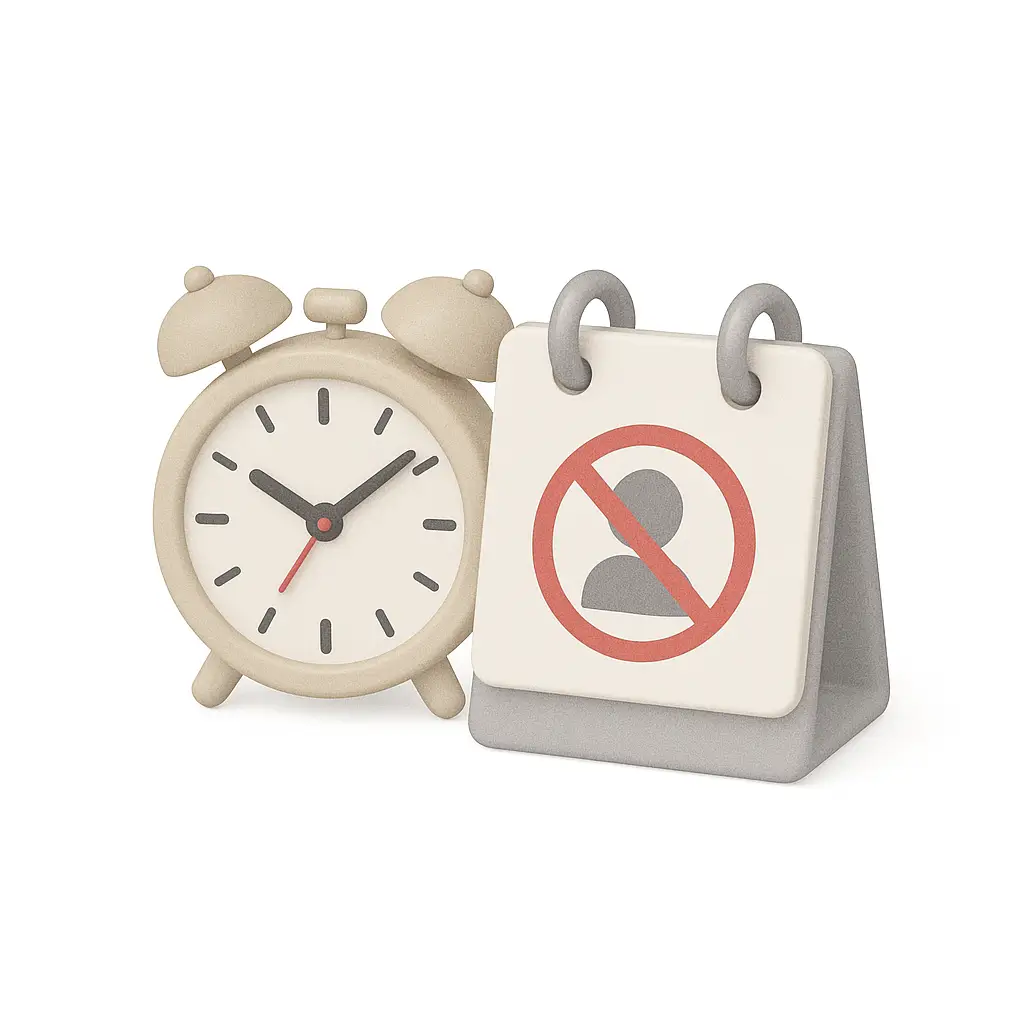No-Meeting Mornings
Protect your mornings for deep, uninterrupted work
July 16, 2025 · 6 min read

📵 The morning meeting trap
Sam opens his laptop at 8:30, ready to push a critical feature across the finish line. Then the calendar pings—30 minutes of stand‑up, followed by two “quick syncs.” By noon, his best thinking hours are gone.
Sound familiar?
No‑Meeting Mornings is a simple policy with outsized returns: protect the first hours of the day for deep, uninterrupted work.
Why mornings?
- Natural peak for many: Cognitive energy and willpower are typically highest after you wake, especially with light, movement, and hydration
- Lower inbound noise: Fewer messages and requests in the early hours
- Momentum effect: One early win sets the tone for the rest of the day
You don’t need perfect science to feel the difference—just compare a meeting‑free morning to a fragmented one.
The core rule
Block the calendar from start of day until a set time (e.g., 9:30–11:30). No internal meetings, recurring ceremonies, or ad‑hoc syncs. Exceptions are explicit and rare.
Policy options
- Daily window: 90–120 minutes every morning
- Anchor days: Tue/Thu mornings meeting‑free for longer stretches
- Team block: One shared morning focus window across the org
Whatever you choose, make it visible and predictable.
How to make it work
1) Put it on the calendar
Create a recurring “No‑Meeting Morning” hold. Color it differently. Treat it like a client meeting: unmovable.
2) Set exceptions up front
- External customer meetings
- Incident response / on‑call
- Hiring interviews with constrained candidate availability
Everything else moves.
3) Shift ceremonies intelligently
- Move daily stand‑ups to late morning or early afternoon
- Batch 1:1s on the same day; keep them short and agenda‑driven
- Convert status updates to async docs or channel posts
4) Pair with notification hygiene
Silence non‑essential alerts during the block (see “Zero‑Notification Zone”). Out of sight, out of mind.
5) Define “urgent” clearly
Write it down (e.g., “customer‑impacting outage,” “legal deadline today”). If it’s not on the list, it waits.
Scripts and templates
- Calendar note: “Heads‑down 9:30–11:30 for deep work. Message for urgent items only.”
- Slack status: “No‑Meeting Morning—replying after 11:30.”
- Email reply for invites: “Thanks for the invite. We protect mornings for deep work. Could we move this to after 11:30 or handle async? Happy to adjust if time‑sensitive.”
Metrics to watch
- Hours of deep work per morning
- Throughput on key deliverables
- Re‑work/defect rate on morning vs. afternoon work
- Meeting load shift (did it just move earlier/later?)
Use the numbers to refine the window and exceptions.
Edge cases and solutions
Global teams: Rotate which region gets morning focus blocks; keep one shared anchor day.
Customer‑facing roles: Shorten to 45–60 minutes and add a second block later.
High‑interrupt environments: Start with two mornings per week; earn trust by showing faster, higher‑quality output.
Seven‑day rollout
Day 1: Announce the policy, define exceptions, and add recurring holds.
Day 2: Move ceremonies; convert status items to async.
Day 3: Run the first protected block. Track one metric (e.g., uninterrupted minutes).
Day 4: Add notification rules and an escalation path.
Day 5: Share early wins and examples of work finished in the block.
Day 6: Adjust the window length based on energy and meeting pressure.
Day 7: Review metrics and lock the default cadence for the month.
Avoid these mistakes
- Turning it into “just fewer meetings”—the goal is zero during the block
- Fuzzy exceptions—write them down and keep them tight
- No async alternative—use short docs, checklists, or recorded updates
- Cramming all meetings into the afternoon—batch thoughtfully to avoid new overload
Bottom line
Protect your best thinking hours, and your best work follows. No‑Meeting Mornings create the conditions for deep progress—every day.
---
If you protected just two mornings this week, what meaningful thing could you ship? Put the holds on your calendar now.
